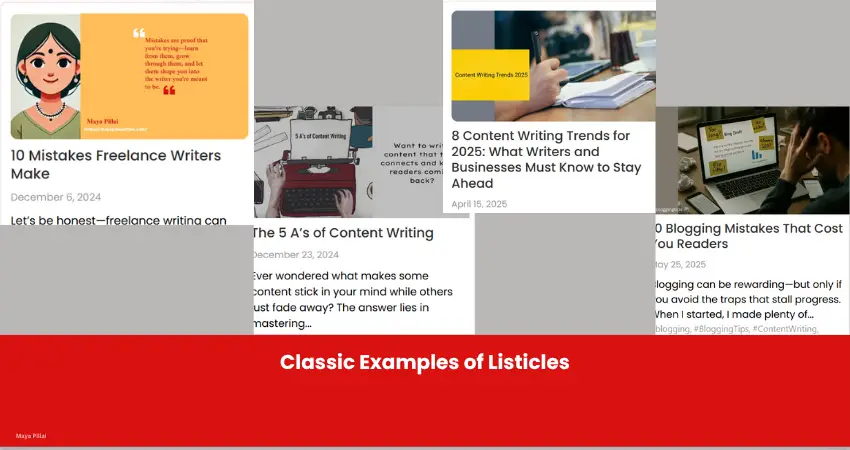Listicles work well, and I’ve seen that firsthand. When I started using them in my blog posts, I noticed something shift—higher clicks, longer time on page, and more reader interaction. The same content in a standard paragraph format didn’t get the same results. That’s when I realized this format isn’t just convenient. It’s effective.
Table of Contents
ToggleIt’s not about being trendy or lazy. It’s about writing in a way people want to read. Times have changed; the attention span of the people are short and competition is everywhere, listicles help your content stand out.

Key Takeaways
- Listicles increase clarity, retention, and engagement.
- They are SEO-friendly, easy to update, and user-first.
- Great for both blogs and client content, especially in crowded niches.
If you’re new to this format or wondering what exactly qualifies as a listicle, check out this detailed guide on what a listicle is.
9 Benefits of Listicles That Make Them Work So Well
- Easy to scan
People rarely read full blog posts word for word. They scan for key information. Listicles present data in a format where readers can easily find what they need without committing to the entire article. Each point works as a mini-topic, making it easier to digest. - Improves readability
Readability directly affects user experience and bounce rate. By breaking content into bite-sized segments with clear headers and white space, listicles reduce visual fatigue. This makes it easier for readers to focus and retain information. - Drives higher engagement
Every list item invites continued reading. A well-crafted listicle encourages scroll behavior, which improves session duration and user interaction. If readers stay longer, they’re more likely to click internal links, comment, or share the post. - Enhances SEO performance
Search engines favor structured content. Listicles often secure featured snippets because the numbered format aligns with how Google parses direct answers. They also allow for strategic keyword placement without overstuffing. - Fits search intent better
Listicles align with the way users phrase queries—”top 10 tips for…” or “ways to…” This direct alignment improves relevance, which boosts click-through rates. Users want quick, actionable answers, and listicles deliver just that. - Easier to update
Unlike narrative posts, updating a listicle is simple. You can add new points, remove outdated ones, or revise sections without disrupting the entire flow. This helps maintain freshness and relevance, both of which impact SEO. - Higher shareability
Social media users prefer sharing content that’s concise and actionable. Listicles get more traction on platforms like LinkedIn, X (formerly Twitter), and Facebook because they are easy to quote, comment on, or summarize. - Builds trust
Well-organized content signals authority. When each point is backed with examples, stats, or tools, readers trust the information more. This trust increases the likelihood of return visits and conversions. - Works across niches
Whether it’s tech, travel, writing, or personal finance, listicles adapt. They can present how-tos, recommendations, mistakes to avoid, or trend roundups with equal efficiency.
10 Psychological Reasons Why Listicles Work
Listicles don’t just perform well because of formatting. They tap into how our brains are wired to consume information. Here’s why they connect so strongly with readers:
- Predictability
Knowing how many points to expect gives the brain a roadmap. If a list promises 10 tips, readers feel more confident committing to the article. - Progress tracking
Each completed point feels like progress. That subtle sense of accomplishment keeps people scrolling through to the end. - Chunking of information
We process data more efficiently when it’s broken into chunks. Listicles support this by separating ideas into bite-sized segments. - Reduced decision fatigue
A long article with no structure can feel overwhelming. A numbered list reduces the choices a reader has to make by offering clearly marked options. - Cognitive ease
The brain prefers simplicity. Listicles use repetition and consistency, making the reading experience smoother and more enjoyable. - Anticipation and curiosity
Each new item creates a small hook: “What comes next?” That micro-curiosity keeps readers engaged longer. - Emotional reward
Completing a list gives a small dopamine boost. Readers feel like they’ve “ticked something off,” even when passively consuming content. - Visual scanning
With numbered points and bold subheads, listicles are easy on the eyes. The design mirrors how people skim content, especially on mobile. - Reduced bounce rates
Since readers know what to expect and can move through content quickly, they’re less likely to exit mid-scroll. - Mental shortcuts
People rely on heuristics to make fast decisions. A numbered list feels more credible and authoritative, helping users choose your article over others.
There’s a reason we prefer lists over blocks of text. It’s not just style—it’s psychology.
- Predictability: Knowing there are 7 or 10 items gives a clear mental map.
- Progress tracking: We feel a sense of accomplishment as we move down the list.
- Chunking: Our brains process information better in groups. Lists use this to their advantage.
This structure plays a key role in retaining attention and improving content recall. Effective listicles usually share three traits:
- A strong promise in the title
- Well-researched, actionable points
- Clean, skimmable layout
Whether it’s “5 Security Tools for Small Businesses” or “7 Mistakes to Avoid When Hiring a Writer,” high-performing listicles solve real problems in a focused way.
To Sum Up
Listicles work well because they make information more accessible. They suit how people read today—fast, distracted, and results-oriented. They’re not about cutting corners; they’re about delivering more value in less time.
If you’re looking to increase reach, engagement, and conversions, the listicle format deserves a spot in your content strategy.
CTA
Want high-performing listicles for your business or client blogs?
Let’s collaborate or browse more writing strategies at mayapillaiwrites.com.
